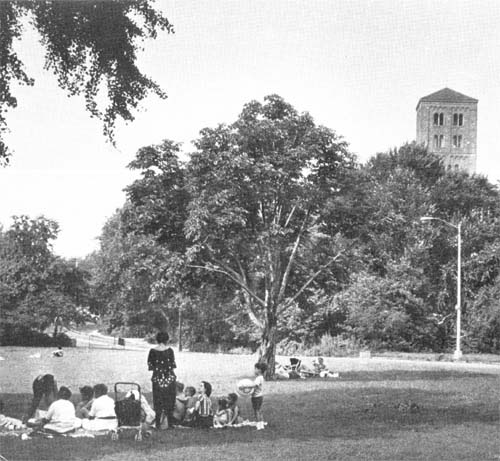
The Cloisters Tower seen from the south, Fort Tryon Park.
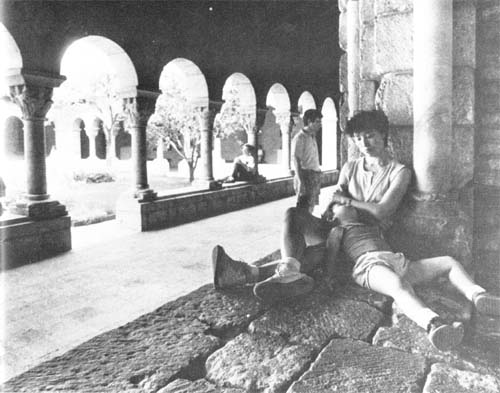
The Cuxa Cloister at the Cloisters in Fort Tryon Park.
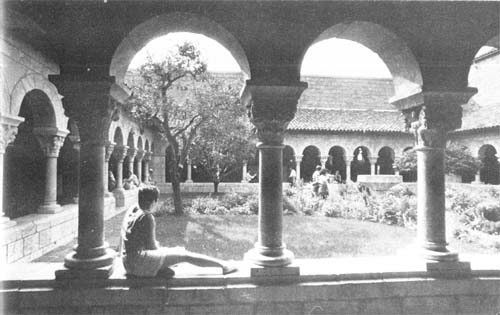
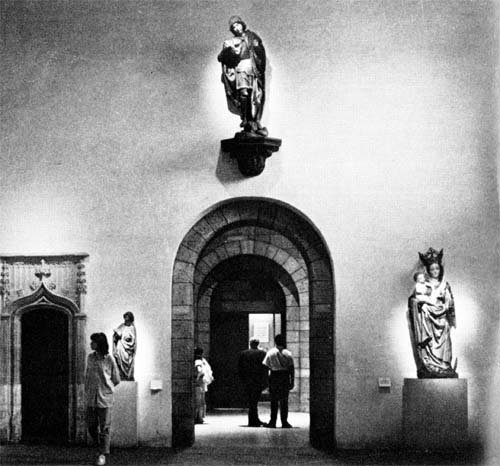
Gothic sculpture and ornament.
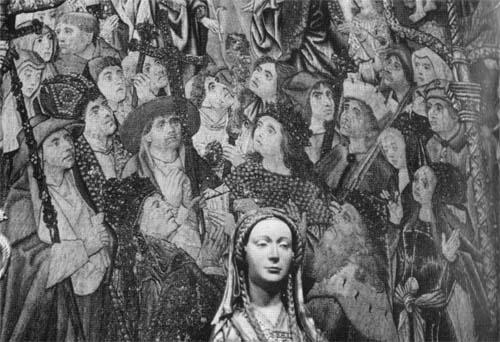
A portion of the tapestry The Glorification of Louis VIII of France.
| Home | Tours/Lectures | Books | Maps | Posters | Pictures | Contact |
FORT TRYON PARK AND THE CLOISTERS
Fort Washington Avenue and 192nd Street
Fort Tryon Park, 66 acres, takes its name from the first fort built in 1779 by the British forces occupying the city. Tryon was William Tryon, last Royal Governor of the Colony of New York.
The site was occupied during the last century by summer residences, including one belonging to Boss Tweed. Around 1900 most of it was the property of C. K. G. Billings, a wealthy fancier of horses. He is remembered, if at all, because of a famous photograph by Byron, now in the Museum of the City of New York, showing Billings and some friends in full evening dress having dinner on horseback in a dining room of Sherry's. The famous restaurant was on the southwest corner of Fifth Avenue and 44th Street, a site now occupied by an uptown branch of Morgan Guaranty. Billings' place was called Tryon Hall.
John D. Rockefeller, Jr. had known the area as a boy when he came riding here. In 1916 the Billings place was on the market and he bought it, adding another parcel to make a total of 40 acres. He offered the land to the city only to have the gift refused by Mayor Hylan.
It so happened that, several blocks to the south, the sculptor George Gray Barnard had his studio. Barnard is represented in the city by the figures in the two pediments of the Fifth Avenue facade of the New York Public Library. He had assembled at his studio parts of several medieval monasteries as well as sculpture which he had purchased in France and Spain. Rockefeller bought the collection and had Charles Collens of Allen, Collens & Willis incorporate the cloisters and chapels into the building we know today. The architect worked with several members of the staff of the Metropolitan Museum, notably James Rorimer. The main building was executed from 1934 to 1938, with additions made in 1961 by Brown, Lawford & Forbes.
The collection boasts of many treasures, above all the famous Unicorn Tapestries. The visitor, however, particularly one interested in parks and gardens, should not overlook the Cuxa Cloister Garth Garden, the Bonnefont Cloister Garden, and the Trie Cloister Garden.
At the same time that the building was under construction, John D. Jr. commissioned Olmsted Brothers to landscape the park. He had offered the land to the city in 1931 and Mayor Walker, unlike Mayor Hylan, accepted it. The park was thrown open to the public in 1935.
The Cloisters is, of course, the great attraction, but the park has its devotees, notably from the neighborhood. When the park was opened it was probably the finest public park, horticulturally, in the country. Among its embellishments was an extensive rock garden set in a retaining wall descending the east slope from near the Cloisters. Unfortunately, although the wall is there the garden no longer exists. The great reward for those interested in plants is the extensive border of broom, Genista, which is to be found west of the road going from the entrance to the Cloisters.
The highest point of the park is the Lookout, 260 feet above sea level, reached by the path which borders the broom. Mention of the Lookout is a reminder that one of the great attractions of the park is the number of splendid views of the Hudson.
The tour goes south from the park entrance along Fort Washington Avenue. At 185th Street it comes to James Gordon Bennett Park which, 265.05 feet above sea level, has the distinction of being the highest natural point in the city. The park is 1.8 acres. It is named for the publisher of The New York Herald because his country place included the site.
The tour continues south on Fort Washington Avenue past the Columbia-Presbyterian Medical Center. At 165th Street it turns west to go downhill to Riverside Drive. Somewhat farther south it will pass below Audubon Terrace where the American Academy–Institute of Arts and Letters, the Hispanic Society of America, the American Numismatic Society and the Museum of the American Indian, Heye Foundation, which has been in the news, are located. Next, above the drive on the left, is Trinity Cemetery where John James Audubon lies buried. At 145th Street can be seen the flat roof of the giant sewage plant which goes south to 137th Street. All the the sewage on this side of Manhattan, from Greenwich Village north to Dyckman Street, is treated in this plant.
At 135th Street the route goes east to Broadway down to Tiemann Place. At Tiemann Place it is uphill, and countertraffic, to Riverside Drive, then left (south) on Riverside Drive to International House.




